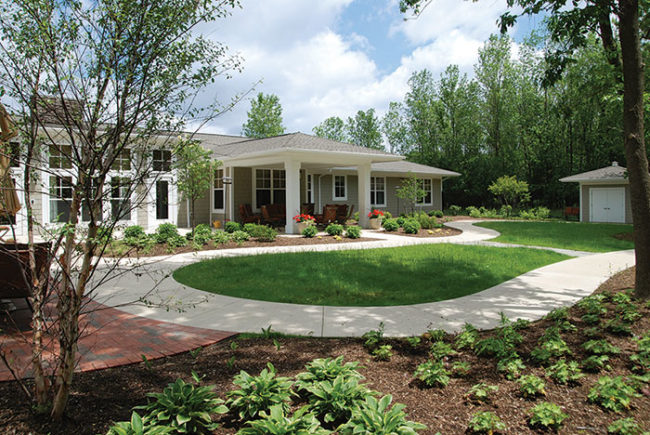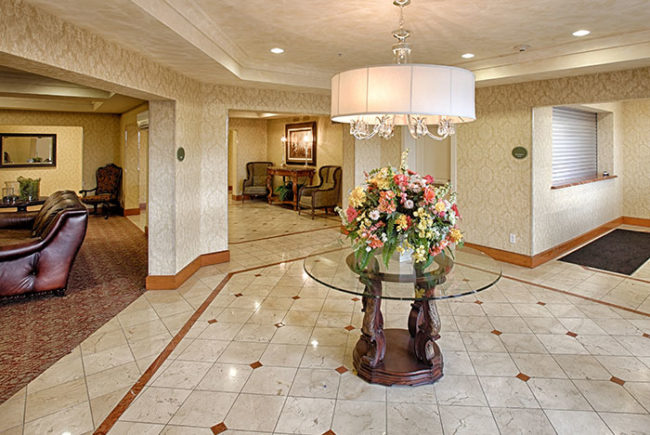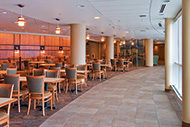
View "Interiors for senior living communities" Gallery
As seniors age, their mobility, senses and preferences change. They have different challenges with everyday activities like eating and walking. They see, hear and smell things differently and may have strong opinions, especially about their surroundings.
Designing specifically for senior living communities must address these physical and emotional changes.
Quality of life
Whether creating a whole community with varying housing and assistance options or designing a stand-alone building dedicated to one area of care, many senior living communities desire the neighborhood concept.
Distinct neighborhoods generally are made up of eight to 20 resident rooms or apartments, each promoting resident independence.
Each neighborhood may include shared areas for interaction, such as a dining room, sitting room, spa, kitchen, activity rooms, indoor sun porches and outdoor patios and gardens. These social areas are critical to drawing residents out of their rooms to prevent isolation and depression.
Fighting boredom is essential for improving the quality of life for seniors. It is important that the resident’s physical, mental and emotional needs are met. Studies show that stimulating the mind can help to exercise not only the body but the brain.
Fitness centers are an emerging trend in senior living communities. They include exercise classes, weight training, therapy pools and cardiovascular equipment.
Research shows that seniors who were cognitively active were 2.6 times less likely to develop Alzheimer’s disease and dementia than those who were not. To keep the mind sharp, “brain gyms” are being used by more senior living communities. These spaces may be rooms that have computers, mind-challenging games, hobby spaces or areas where seniors can express creativity by painting, singing and drawing.
Creating a variety of dining options is another way to engage the resident in a pleasant dining experience. Who doesn’t like to have dining options — whether it is a casual bistro for a burger, café for soup and salad, or a formal dining space for a more fine-dining experience?
Other types of social areas include beauty salons, billiard rooms and sitting rooms designed to bring residents together for an afternoon bridge game, garden club meeting or a sports event on TV. And cozy, light-filled, four-season porches that overlook gardens are conducive for small gatherings.
In the last decade, country kitchens also have been incorporated into the design of senior living communities. These kitchens are open, available to all residents and used for group cooking sessions. They may look like a kitchen in their own homes. In addition, these can be therapeutic. The aromas can help to stimulate the residents’ appetites and evoke feelings of comfort.
Outdoor spaces might include shuffleboard, croquet, putting greens, walking paths or raised gardens.
Safety and accessibility
Every design should start with safety as a priority and it must be balanced with how caregivers can perform, how homelike the facility feels for residents and their families, and how well it can be maintained by staff.
Because the functional abilities of seniors are reduced, they can experience difficulty navigating the built environment. Seniors may experience weakening joints, poor vision, declining spatial skills, loss of hearing and frailty, and are at higher risk for falls and injuries. Layout, colors, textures, lighting and many other considerations are factors in creating a safe and effective healing environment for seniors.
Closely related to safety, access into and around the facility is also important for seniors with mobility issues.
Seniors tend to perceive tile and waxed floors as being slick whether or not the floor is actually slippery. This can make them unsteady on their feet. To help reduce the real or perceived risk of slips and falls, many health care facilities are minimizing waxed and tiled flooring and are using nonglare flooring.
There are many other products that are pleasing to the eyes and easy to maintain — vinyl plank flooring that simulates wood, for instance. With a 20-mil wear layer and no need for wax, it’s extremely easy to maintain and works well in homelike environments.
Many seniors shuffle their feet, so it is critical to create smooth transitions to reduce tripping hazards. Some flooring manufacturers offer products that eliminate transition strips. For instance, sheet vinyl and carpet can be chemically welded at the seams, eliminating the transition strip and reducing the tripping hazard.
To make it easier and more desirable for seniors to keep moving, designers should consider incorporating indoor walking paths or corridors. These paths should be wide and free of obstacles. If possible, health care designers should consider shorter hallways and avoiding dead ends by connecting paths. If there needs to be an end point, it should be to a destination such as the kitchen or another common area. It’s also a good idea to provide built-in seating to allow seniors to rest along the way. Handrails and lean rails can allow a continuous accessible path throughout a building.
It is beneficial to position doors that lead directly to the outdoors in convenient locations, such as directly off living rooms. These outdoor areas can be secure and have barrier-free sidewalks that encourage residents, family and staff to go outside. Placing benches along the paths provides opportunities for rest.
To accommodate hand impairments, designers should consider different lever handles as well as graspable grab bars and cabinet pulls. And, because obesity is expected to be a problem among baby boomers, designers should consider wider door openings and beds as well as bariatric lifts.
Acoustics and lighting
Good acoustics means quieter environments, which reduces stress, anxiety, irritability and confusion for seniors and others.
To help reduce noise and create a quiet, calming environment, designers should consider acoustical ceilings with high noise-reduction coefficients. In some instances, acoustic wall panels could be added to reduce noise when reverberations may be too high otherwise, as in most dining rooms.
Ceiling clouds or suspended acoustic panels can be used in lobby areas where there typically is hard surface flooring. Carpet also can be used to help reduce noise in common spaces.
Seniors require environments with high lighting levels because of changes in their vision. In addition to reducing stress, this will provide a safer environment for seniors.
Natural light aids vision and also can lift spirits, provide operational savings and help with the connection to nature. Many senior living communities strive to have at least one window in each resident room. For semiprivate rooms, one window per resident is a great goal. To increase daylighting, designers should consider skylights or incorporate half walls to allow natural light to filter from common areas into interior circulation spaces.
Aging eyes take longer to adjust from one room to another. Ambient light helps with this adjustment, and making sure that light fixtures do not flicker or hum also can aid in senior comfort and safety.
Seniors also struggle with impacts of glare in the performance of everyday activity. If painting walls, health care facilities should select paint within a specific light reflective value (LRV) range. The higher the number, the more light will be reflected. For seniors, the best paint to select has a 40 to 60 LRV range. Another way to minimize glare is to choose window shades that provide diffused lighting and eliminate glare.
Lighting during the night also is an important consideration. It is needed to keep seniors safe, but too much lighting can interrupt residents’ sleep cycles. To find the right balance, designers should position hallway lighting away from resident doors.
Finish choices
While safety is first and foremost in senior design, emotional cues are important, too. How a community looks can help families to feel confident in leaving their loved ones in the community’s care. Residents themselves want to be in surroundings that are familiar and comfortable.
Evidence-based design shows a strong connection between healing and stimulating interiors — spaces that have an interesting use of color, focus on nature and are not too neutral.
Colors and patterns. Colors are a huge part of aesthetics. Generational preferences and how eyes perceive colors can vary among age groups. Seniors typically see 20 percent less color saturation and often have yellowing of the eye lens, which makes colors appear yellower to them.
Colors found in nature can reduce stress levels significantly and also promote healing.
Watery shades of beach glass, topaz and blues promote peace and serenity. Blues and green wavelengths also are easier to perceive, making them more restful. Earthy shades of rock, stone, terra cotta, espresso and soil connect residents to the natural world. Wood shades of soft moss, leaves and lichen promote balance and harmony. Air shades of linen, white and cream promote sincerity, hope and spirituality.
Soft colors or colors of similar intensities are difficult for the aging eye to discern; pastels will appear dull and sometimes gray to seniors. More saturated hues are easier for the aging eye to decipher.
Studies indicate that seniors have an aesthetic appeal toward certain patterns and textures. Designers should be careful about the introduction of patterns for wall coverings and carpets though. Subtle patterns that aren’t confusing are more appropriate than bold geometric forms or high-contrast graphics.
It’s best to select patterns that do not encourage a perception of visual movement. Patterns can be visually disturbing to aging eyes and can cause agitation. Designers should avoid big floral patterns, because these patterns appear to crawl and move. Avoiding hard edge strips also is recommended because these patterns appear to vibrate.
Colors as visual cues. Similar-toned walls and floors make it difficult for aging eyes to see where one surface ends and the next begins. To help alleviate this confusion — and make the environment safer for seniors — contrasting colors should be used. Contrasting colors between walls and floors, steps and landings, and furnishings and floors help to differentiate between surfaces and planes.
Similarly, designers of senior living communities should consider introducing pops of color at key activity areas to stimulate the residents and to add definitive destinations in corridors.
In restrooms, it is important for residents to see the color differential between a white wall fixture and the color of the wall and floor. This can be accomplished by introducing queuing walls that are a contrasting color to the restroom fixtures. Some senior communities also choose to use bold-colored toilet seats to help the resident differentiate the plumbing fixtures.
When designing memory care communities, it is good for designers to minimize the entry. Any doors that are not part of the program space can be painted to match the wall color so they blend in with the corridor. This helps with wayfinding and minimizes anxiety. Residents can use their indoor wandering trails without being distracted by a lot of doors.
About this article
This feature is one of a series of quarterly articles published by Health Facilities Management in partnership with the American Academy of Healthcare Interior Designers. 
Artwork. Selecting colorful images to which residents can relate is a great tool for activity areas.
One option for interior designers is working with local photographers and selecting a theme for the facility. For example, a seasonal theme could show artwork based on nature scenes that relate to each season. One neighborhood could be pictured in summer, fall and spring. This is particularly helpful in memory care facilities, where familiar images can assist the residents by triggering memories and helping to spark conversations between caregivers and residents.
Properly attaching the artwork to the wall with security hangers ensures that it is a safe addition to the built environment.
Special requirements
Senior living communities have many special requirements that designers must take into consideration. Considering demographic trends, these requirements will be challenging to a wide swath of the health care design community in the coming years.
Mary E. Turgeon, AAHID, LEED AP ID+C, is principal; Rebecca Day Dillon, AIA, LEED AP BD+C, is architect; and Deirdre L. Pio, CSI, CDT, is project manager at Gawron Turgeon Architects, Scarborough, Maine. They can be reached at mturgeon@gawronturgeon.com, rdillon@gawronturgeon.com and dpio@gawronturgeon.com, respectively.
Selecting the right furniture for senior living
Furniture has both an aesthetic and functional role in senior living facilities by providing an appealing environment and also preventing injury.
It should be durable, comfortable, the correct height and easy to get into and out of even for those with limited mobility. The layout of the furniture also should allow for safe mobility, whether the residents can walk on their own, use walkers or are in wheelchairs.
Health care facilities should select chairs with arms that allow seniors to lift themselves to a standing position. Furniture set at the proper height and with firm seat cushions provides assistance for standing upright. If benches are being used in a facility, they should have back supports and arms.
Furniture textile selection is important, especially with regard to maintainability. Designers should select textiles that are made from environmentally friendly crypton material to help prevent staining and improve cleanability from spills and incontinence over time. To reduce the spread of disease, a moisture barrier should be provided to prevent bodily fluids from penetrating into the furniture assembly. For durability, furniture textiles should have a wear surface of at least 90,000 double rubs to increase the lifetime of the fabric.
Designs for dementia patients should provide square tables versus round. Square tables not only define a sense of space for each resident, but they also provide defined edges to which they can relate. Designers should also consider selecting contrasting edge bands for tables. These alert residents that there is a color change from the edge of the table to the floor, which helps to eliminate spills.





